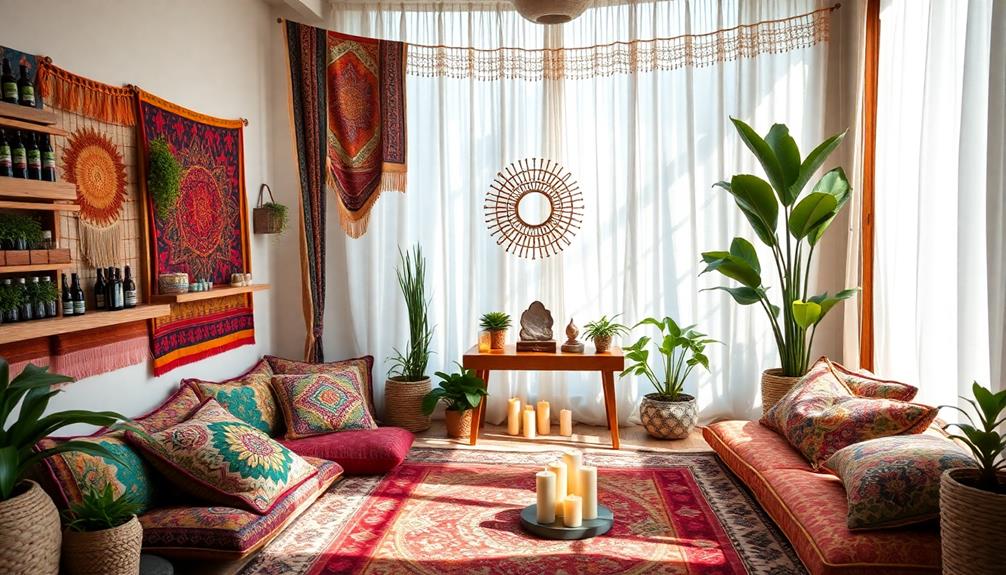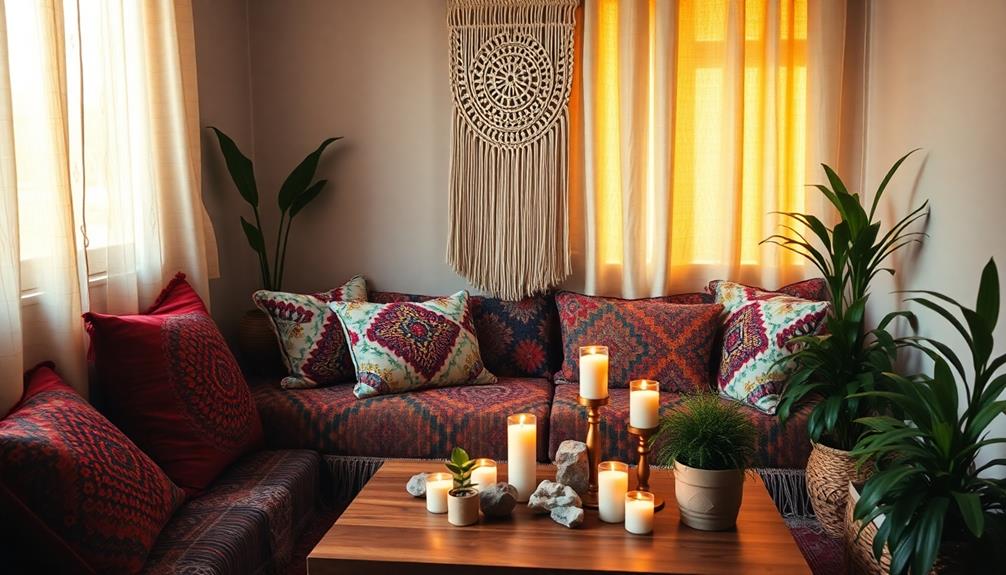Embracing Ayurvedic practices can elevate your boho lifestyle into a harmonious fusion of health and artistic expression. Begin by understanding your dosha, which will guide you in selecting the right foods and color schemes for your environment. Integrate yoga and breathing exercises to improve digestion and emotional stability. Adapt your self-care regimen based on seasonal changes, such as incorporating cooling foods during the summer months. Foster emotional wellbeing through journaling and connecting with nature. Decorate your living space with cozy textures and vibrant hues that resonate with your individual energy. Delve deeper into these principles to uncover a multitude of ways to enhance your boho lifestyle.
Key Takeaways
- Embrace seasonal self-care by adjusting your diet and practices according to seasonal changes, focusing on cooling foods during summer to balance Pitta.
- Incorporate yoga and mindful breathing techniques to enhance digestion and reduce stress, promoting overall well-being in a boho lifestyle.
- Utilize calming essential oils and engage in creative outlets like journaling to maintain emotional balance and resilience in daily life.
- Style your home with dosha-inspired aesthetics, using soothing colors and natural materials that resonate with your personal energy for a harmonious environment.
- Foster connections with nature through outdoor meditation and grounding practices, enhancing your spiritual wellness in the boho living experience.
Understanding Ayurveda
What makes Ayurveda stand out as a holistic health system? This ancient practice, originating in India over 5000 years ago, focuses on the balance between body, mind, and spirit for overall well-being. It emphasizes that true health comes from understanding and maintaining this balance.
Ayurveda identifies three primary doshas—Vata, Pitta, and Kapha—that represent different energies within you. Understanding your dosha can help you make informed lifestyle choices tailored to your unique constitution. Additionally, adopting eco-friendly practices can enhance your Ayurvedic journey by promoting a healthier environment and supporting sustainable living.
You'll find that Ayurveda looks at the connection between food, digestion, and health. It posits that many illnesses arise from poor digestive function, so it's a great time to pay attention to what you eat. Make sure you incorporate dietary changes, yoga, and lifestyle adjustments that promote harmony within your body.
Additionally, Ayurvedic practices emphasize seasonal self-care routines, aligning your wellness with nature's rhythms. By adopting these practices, you not only enhance your physical health but also nurture your emotional well-being.
Embrace Ayurveda as a guide to living in balance, and you'll likely discover a more vibrant, fulfilling life.
The Role of Digestion
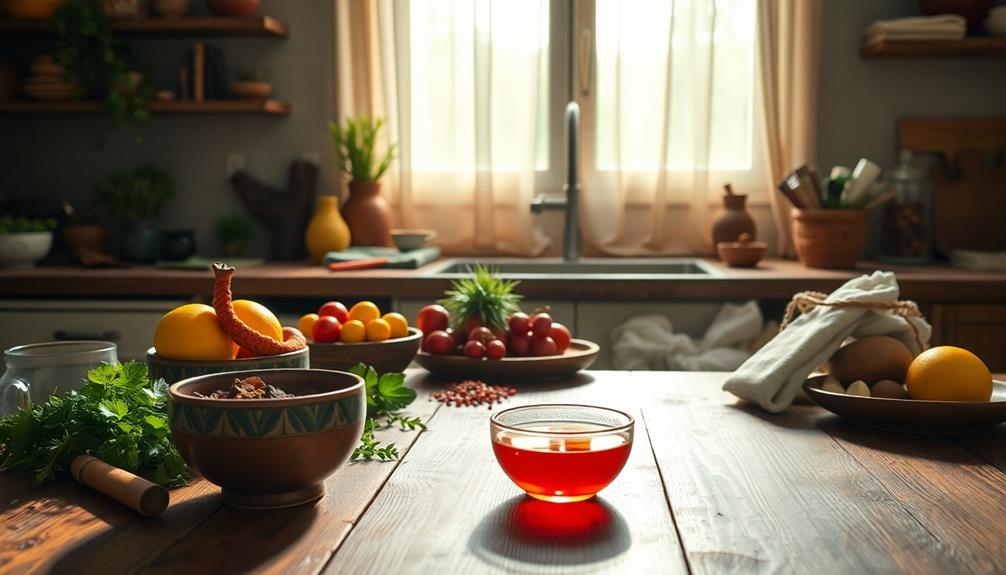
Digestion plays an essential role in Ayurveda, as it's seen as the foundation of overall health. When your digestive function falters, it can lead to a range of physical and emotional health issues.
To enhance your digestive health, focus on incorporating clean, unprocessed foods into your diet. These nutrient-rich options not only improve digestion but also help maintain your energy levels throughout the day. Additionally, using crucial oils like eucalyptus oil can support respiratory health and overall well-being, which indirectly benefits digestion.
Regular physical activity is crucial too. Engage in yoga practices, especially deep twists, as they stimulate your digestive tract and boost metabolic function.
Alongside this, practice mindful eating and incorporate conscious breathing techniques to support your digestion and enhance nutrient absorption.
Establishing daily rituals can further promote ideal digestive health. Consider taking long walks after meals to aid digestion and encourage healthy movement.
Self-massage with suitable oils can also be beneficial, helping to relax your body and improve circulation.
Yoga for Digestive Health

Yoga offers a powerful way to enhance your digestive health, making it an essential practice in Ayurvedic living. Incorporating deep twists in your asanas greatly boosts blood flow to your digestive organs, promoting better digestion and metabolism.
You'll find that these movements help not just with digestion but also with overall well-being. Additionally, practicing yoga can help alleviate stress and anxiety, which are known to impact digestive health negatively. For more insights on promoting wellness through mindfulness, check out supporting a partner ready for parenthood.
Conscious breathing techniques during your practice stimulate your digestive system, alleviating bloating and discomfort. Regular yoga not only improves digestive efficiency but also strengthens your immune system through enhanced circulation.
After meals, consider gentle stretches or a short walk to aid digestion and prevent that sluggish feeling. Mindful yoga sessions encourage you to tune into your body, making it easier to identify and address any digestive discomforts.
Seasonal Ayurvedic Practices
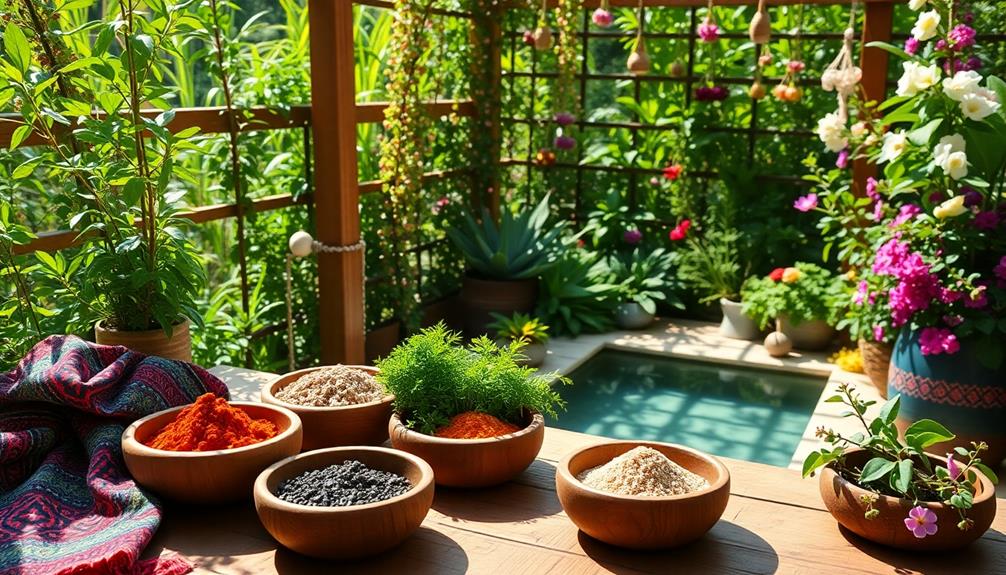
As the seasons change, so do our bodies' needs and rhythms, making it important to adapt your Ayurvedic practices accordingly.
During the summer months, when Pitta peaks, you can maintain balance by incorporating cooling foods and self-care routines. Implementing structured practices can enhance your overall well-being, similar to how best practices in software quality assurance guarantee peak results in development.
Here are some practices to take into account:
- Eat Cooling Foods: Focus on foods like cucumbers and tender greens to prevent internal heat build-up.
- Adjust Your Yoga: Instead of heated yoga sessions, try Yin and restorative yoga to soothe your body and mind during the warmer days.
- Support Digestive Health: Take long walks after meals and indulge in self-massage with cooling oils, such as coconut oil, to enhance digestion and relax your body.
- Enhance Emotional Well-Being: Make time for journaling, connect with friends, and create space to process any stress or negative feelings that may arise.
Dietary Guidelines for Summer

Summer invites a shift in your dietary choices to keep your body in harmony with the season's heat. During these hot months, focus on cooling foods like cucumbers, celery, and tender greens to balance the fiery Pitta dosha. Incorporating raw foods and fresh meals not only enhances your energy levels but also promotes ideal digestion.
Additionally, consider adding nutrient-rich options like baked kale, which retains essential vitamins and minerals, making it a great choice for summer baked kale nutrition.
Make sure to include herbs and spices that keep you cool, such as fennel, mint, cilantro, coriander, and cumin. Cumin, in particular, is great for alleviating bloating and supporting digestion. Glowing green smoothies made with hydrating ingredients are also fantastic for maintaining nourishment and hydration in the heat.
As you navigate summer, practice portion control and lean towards lighter meals. Heavy dishes can lead to discomfort and sluggishness in the heat. Instead, opt for meals that are easy on your digestive system, allowing you to stay energized and refreshed throughout the day.
Body Practices for Balance

To maintain balance during the warmer months, incorporating body practices can greatly enhance your well-being. Here are some effective strategies to contemplate:
1. Self-Massage (Abhyanga): Use cooling oils like coconut oil for regular self-massage. This practice soothes the body and balances Pitta, especially essential in hot weather.
Additionally, integrating essential oils like lavender can provide calming effects, promoting relaxation and emotional balance through aromatherapy benefits.
2. Yin and Restorative Yoga: Engage in Yin or restorative yoga instead of heated styles. These practices promote relaxation, support digestive health, and counteract internal heat.
3. Post-Meal Walks: Take long walks for 10-15 minutes after meals. This simple act aids digestion and improves circulation, enhancing your overall wellness.
4. Cooling Herbs and Spices: Incorporate cooling herbs and spices, such as mint and coriander, into your meals.
These can alleviate bloating and promote digestive comfort, keeping you feeling light and refreshed.
Emotional Wellness Techniques
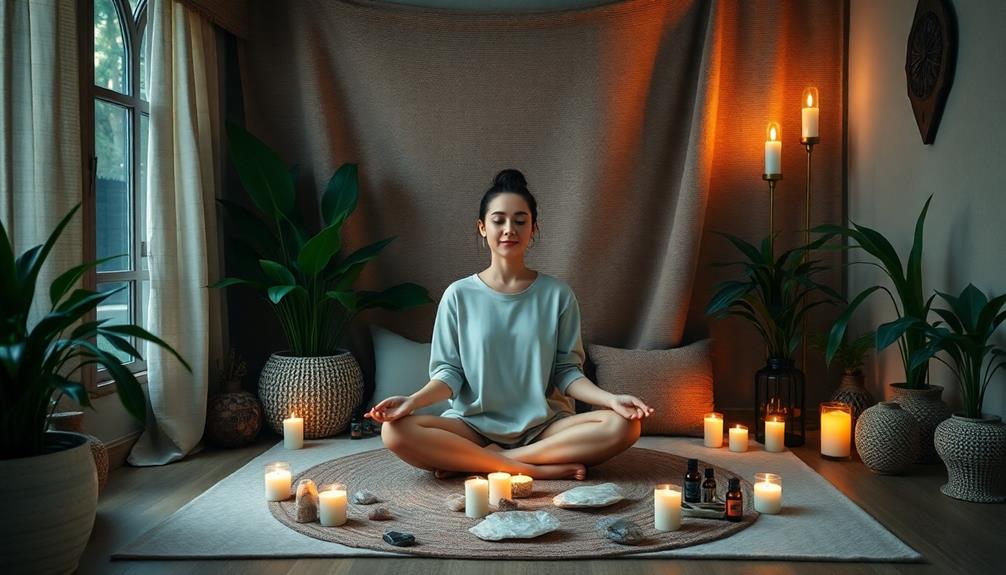
Emotional wellness plays an essential role in maintaining balance, especially during the heat of summer when Pitta energy can heighten stress and agitation. To navigate these emotional waves, you can employ several effective techniques.
| Technique | Description | Benefits |
|---|---|---|
| Mindfulness Practices | Engage in deep breathing and meditation | Reduces stress and enhances calm |
| Journaling | Write down your thoughts and feelings | Processes emotions and clarifies thoughts |
| Social Connections | Spend time with friends and loved ones | Alleviates isolation and anxiety |
| Daily Emotional Time | Dedicate time for self-reflection and affirmations | Boosts overall emotional health |
| Grounding Activities | Walk barefoot on grass or practice outdoor yoga | Strengthens mind-body connection |
Spiritual Practices in Ayurveda

In Ayurveda, connecting with your spirit is essential for overall well-being.
By practicing mindful breathing, engaging in outdoor meditation, and journaling for emotional clarity, you can cultivate a deeper sense of peace and awareness.
Techniques such as cleansing and protecting spiritual energy can further enhance your spiritual practices, helping to clear negative energy and maintain balance.
These spiritual practices not only enhance your inner calm but also nurture your connection with nature and yourself.
Mindful Breathing Techniques
Breathing mindfully can transform your daily routine into a sacred practice that nurtures both body and spirit. By focusing on your breath, you can calm your mind and balance your body's energies, enhancing overall well-being.
Incorporating practices like portable camping toilets can also contribute to a more comfortable outdoor experience, allowing you to focus on your spiritual journey without distractions.
Here are some techniques you can incorporate into your practice:
- Diaphragmatic Breathing: Take deep, slow breaths from your diaphragm. This technique increases oxygen flow, aiding digestion and reducing stress levels.
- Nadi Shodhana (Alternate Nostril Breathing): This pranayama exercise helps to harmonize your doshas and emotional states, promoting inner peace.
- Regular Practice: Set aside just a few minutes daily for mindful breathing. This consistent practice can notably impact your emotional health and resilience against stress.
- Enhance Mental Clarity: Engaging in mindful breathing improves focus and contributes to a deeper spiritual connection, enriching your overall mindfulness.
Outdoor Meditation Practices
Mindful breathing lays a strong foundation for outdoor meditation practices that deepen your spiritual connection with nature. Find a quiet spot at dawn or dusk, when the world feels serene, and immerse yourself in the calming energy of the environment.
As you settle down, consider grounding yourself by sitting directly on the grass or earth. This practice helps balance your energy and strengthens your bond with the natural world. To enhance your experience, you might also consider diffusing essential oils like lavender or chamomile, which are known for their calming effects and can further promote relaxation and peace in your meditation space. Incorporating these essential oils for relaxation can create a soothing atmosphere that complements your mindfulness practice.
Incorporate deep breathing exercises into your meditation. Focus on inhaling deeply and exhaling fully; this simple technique can greatly reduce stress and enhance mental clarity. As you breathe, visualize the fresh air nourishing your mind, body, and spirit.
To enrich your meditation, surround yourself with natural elements like flowers or plants. These additions create a tranquil atmosphere that supports mindfulness and relaxation.
Practicing in nature encourages you to embrace a holistic approach to spirituality, recognizing how interconnected your mind, body, and spirit truly are.
Journaling for Emotional Clarity
Journaling acts as a powerful tool for achieving emotional clarity, allowing you to unravel complex feelings and thoughts on paper.
In Ayurveda, this practice enhances mindfulness, helping you observe your emotions without judgment. By regularly expressing your thoughts, you foster a deeper understanding of your inner self, leading to improved emotional well-being.
Engaging in journaling can also help you unveil the magic of the Vortex, enhancing your connection to your desires and inner peace through self-reflection and intention-setting exploring emotional well-being.
Consider incorporating these four journaling techniques to deepen your practice:
- Daily Reflections: Spend a few minutes each day writing about your emotions and experiences. This helps identify patterns and triggers affecting your mood.
- Gratitude Prompts: List three things you're grateful for each day. This simple exercise shifts your mindset to a more positive state, enhancing mental health.
- Emotional Check-Ins: Write about how you feel at various points during the week. By tracking your emotions, you gain insights into your emotional landscape.
- Personal Growth Goals: Set intentions for self-improvement. Documenting your aspirations can motivate you and clarify your path to holistic wellness.
Home Styling by Dosha

When styling your home according to your dosha, you'll want to contemplate how each one influences your space.
Vata-inspired designs bring in cozy aesthetics with soft colors, while Pitta's approach cools things down with revitalizing palettes.
Kapha, on the other hand, energizes your environment with bold statement pieces that invigorate your living area.
Vata-Inspired Cozy Aesthetics
Creating a Vata-inspired cozy aesthetic in your home can transform your space into a serene retreat. By focusing on light, calming elements, you can nurture a peaceful environment that embodies Vata's airy nature. Here are some key aspects to reflect upon:
- Color Palette: Use neutrals like white and beige, along with soft pastels such as pink and mint green, to create a soothing atmosphere.
- Textures: Prioritize cozy and soft fabrics. Contemplate plush throws and quilted pillows that invite relaxation and warmth into your living space.
- Materials: Incorporate light-colored wood in furniture and decor. This not only enhances the airy feel but also adds a touch of natural elegance.
- Patterns: Opt for small geometrics or stripes, steering clear of busy designs that can overwhelm the senses.
Pitta's Cool Color Palette
Embracing Pitta's cool color palette can elevate your home into a tranquil oasis. Focus on soothing shades like navy, indigo, turquoise, and greens to create a calming atmosphere. These colors not only promote relaxation but also enhance your space's aesthetic.
Incorporate silver metal accents to further enrich the invigorating feel of your Pitta-inspired decor. Think about adding items like an indigo storage side table or gray marbled pillows; both effectively complement the Pitta vibe while maintaining harmony.
Don't forget to include decor accents like flowers and plants. They bring energy and a touch of nature indoors, grounding the cool palette with life.
Choose lightweight fabrics featuring marbled or wave patterns to add texture and elegance without introducing warm colors that might disrupt Pitta's balance.
Kapha's Bold Statement Pieces
Kapha home styling brings a lively contrast to the serene environment created by Pitta's cool color palette.
You'll find that incorporating bold statement pieces in warm colors like reds, oranges, and terracotta creates an inviting atmosphere that energizes your space.
Textures play a significant role here; cozy fabrics and wool add warmth and comfort, making your home feel welcoming.
To embrace Kapha's aesthetics, consider these key elements:
- Warm-Colored Woods: Use rustic furniture to ground your space and create an earthy ambiance.
- Eye-Catching Patterns: Incorporate geometric shapes and large florals to add visual interest and energy.
- Plush Seating: Opt for large, comfortable sofas or chairs that invite relaxation and conversation.
- Layered Textiles: Combine various fabrics like throw blankets and cushions to enhance comfort and create a cozy vibe.
Frequently Asked Questions
How to Live Your Life According to Ayurveda?
To live according to Ayurveda, you'll balance your dosha through mindful eating, yoga, and seasonal adjustments. Prioritize digestion, embrace clean foods, and incorporate mindfulness practices to nurture your emotional well-being and enhance your overall harmony.
How to Begin an Ayurvedic Lifestyle?
To commence an Ayurvedic journey, you'll need to reveal your dosha's essence. Tailor your meals, establish a mindful routine, and embrace nature's rhythm—each step nurtures your body's harmony and invigorates your spirit.
What Is the Feng Shui of Ayurveda?
Feng Shui in Ayurveda focuses on balancing energies in your space. You'll enhance harmony by arranging furniture mindfully, using natural materials, and incorporating plants to create a calming environment that nurtures your well-being.
What Is the Ayurvedic Lifestyle?
Imagine a gentle river flowing through your life, harmonizing your body and mind. The Ayurvedic lifestyle embraces this rhythm, balancing nature's elements, nourishing yourself with wholesome foods, and cultivating mindfulness to foster overall well-being and energy.
Conclusion
Embrace the vibrant essence of boho living by weaving Ayurvedic practices into your daily routine. Nourish your body with seasonal foods, harmonize your mind through yoga, and elevate your spirit with meditation. Surround yourself with decor that resonates with your dosha, creating a sanctuary that reflects your unique energy. By honoring digestion, balancing emotions, and nurturing your spirit, you'll cultivate a holistic lifestyle that celebrates wellness, creativity, and connection in every aspect of your life.

